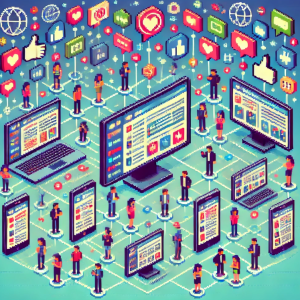
Nano or Macro? How Small Influencers Make a Big Impact in Public Health
In the bustling world of social media, influencer marketing has quickly become a powerful tool for brands looking to connect with their audiences. But with so many influencers to choose from, how do you know who will drive the best results? A new study has shed light on this very question, and the findings are nothing short of revolutionary. For public health practitioners and researchers, these insights could open up a whole new world of opportunities to leverage social media in ways that were previously overlooked.
The Power of Influence: It’s Not What You Think
Influencer marketing is no longer a novelty; it’s a booming $17.4 billion industry that shows no signs of slowing down. Companies worldwide are increasingly turning to influencers—individuals who have garnered a following on platforms like Instagram—to promote their products or services. The idea is simple: if an influencer endorses a product, their followers are more likely to make a purchase.
But here’s where it gets interesting. For years, the prevailing wisdom has been that the bigger the influencer, the better. Brands have flocked to macro-influencers—those with hundreds of thousands or even millions of followers—believing that their vast reach would translate into higher sales. However, the latest research challenges this assumption.
Bigger Isn’t Always Better: The Rise of Nano-Influencers
The study, which analyzed a staggering 1.8 million purchases linked to over 2,800 Instagram influencers, found that targeting low-followership influencers—often referred to as nano-influencers—actually outperforms their macro counterparts by a wide margin. In fact, nano-influencers generated significantly higher returns on investment (ROI) across multiple metrics, including revenue per follower and return on influencer spend (ROIS).
But why is this the case? The answer lies in the level of engagement. As influencers gain more followers, their engagement rates typically decline. This means that while a macro-influencer might have a larger audience, the connection they have with their followers tends to be weaker. On the other hand, nano-influencers, with their smaller but more dedicated followings, foster stronger relationships and higher levels of trust. Their followers are not just passive viewers; they are active participants who are more likely to engage with content and, ultimately, make purchases.
Public Health Implications: A New Frontier for Influencer Marketing
So, what does this mean for public health? The implications are profound. Public health campaigns often struggle to engage target audiences, particularly in marginalized communities. Traditional marketing methods may fall flat, but influencer marketing—especially when harnessed through nano-influencers—could be the key to bridging this gap.
Imagine a public health initiative aimed at increasing vaccination rates in a specific community. Instead of partnering with a well-known celebrity or macro-influencer who might not have a genuine connection with that community, public health officials could collaborate with local nano-influencers. These influencers, who are often seen as peers rather than distant figures, can deliver messages that resonate on a personal level. Their followers are more likely to listen, engage, and take action, leading to higher participation rates in health programs.
Moreover, the cost-effectiveness of working with nano-influencers makes this approach accessible even to smaller public health organizations with limited budgets. By focusing on influencers who already have a strong bond with their followers, public health campaigns can achieve more significant impact without the hefty price tag that comes with hiring macro-influencers.
Real-World Example: Influencers in Action
Let’s take a real-world example. During the COVID-19 pandemic, misinformation about vaccines spread rapidly across social media. Public health authorities faced the daunting task of combating these falsehoods while encouraging people to get vaccinated. In some cases, they turned to influencers to help spread accurate information.
But rather than focusing solely on celebrities or big-name influencers, some health organizations tapped into the power of nano-influencers. These smaller influencers, who were already trusted voices within their communities, played a crucial role in disseminating reliable information and countering misinformation. Their posts, which often featured personal stories and experiences, struck a chord with followers, many of whom were hesitant about the vaccine. The result? A noticeable increase in vaccine uptake in areas where these nano-influencers were active.
Opportunities for Public Health Practitioners
The research opens up exciting possibilities for public health practitioners. Here are a few ways influencer marketing can be integrated into public health strategies:
- Community-Specific Campaigns: Target influencers who are deeply embedded in specific communities. These individuals can help tailor messages to the unique needs and concerns of their followers, making public health campaigns more relevant and effective.
- Cost-Effective Outreach: With nano-influencers, even small public health organizations can afford to launch impactful campaigns. The ROI for these influencers is much higher, meaning your budget goes further.
- Building Trust: In the realm of public health, trust is everything. Nano-influencers, with their authentic and relatable content, can help build trust in public health initiatives, leading to better outcomes.
The Future of Public Health and Influencer Marketing
As public health continues to evolve in the digital age, the role of influencer marketing is set to grow. This study’s findings highlight the importance of looking beyond follower counts and focusing on the quality of engagement. For public health practitioners, this means rethinking traditional approaches and embracing the potential of nano-influencers to drive meaningful change.
The next time you’re planning a public health campaign, consider partnering with nano-influencers who have a genuine connection with their followers. Not only could this approach lead to better engagement and outcomes, but it also offers a cost-effective way to reach even the most hard-to-reach communities.
Join the Conversation
What are your thoughts on using nano-influencers for public health campaigns? Have you seen successful examples of influencer marketing in public health? Share your experiences and ideas in the comments below, or join the discussion on social media!
Empower Your Network – Subscribe and Share!
Unlock key insights with ‘This Week in Public Health.’ Subscribe for free and share to drive change as part of a dedicated community. If you liked this blog, please share it! Your referrals help This Week in Public Health reach new readers.



